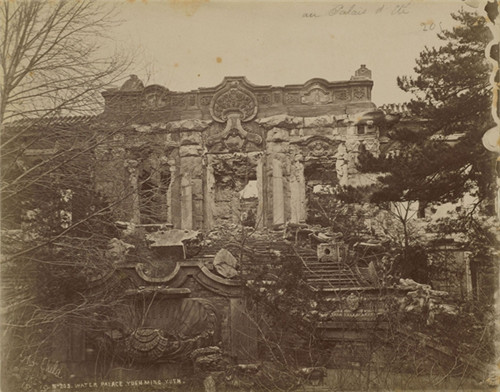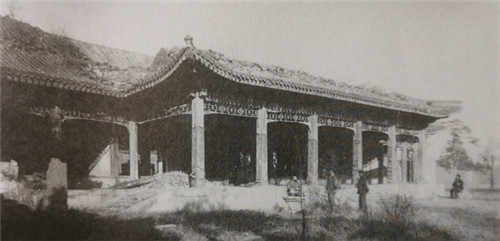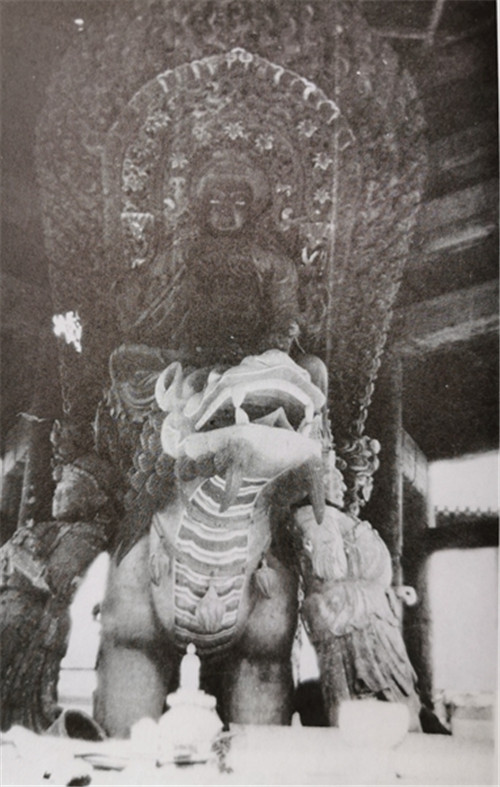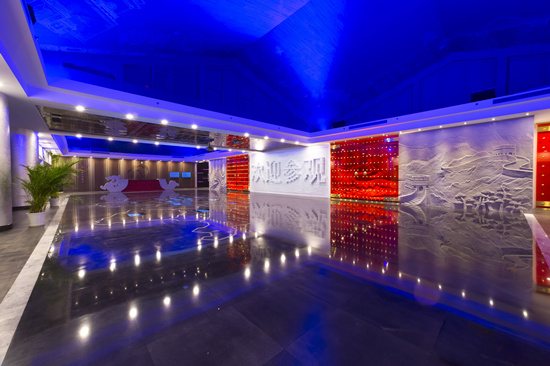A calling of history

A photograph, taken in 1877 by Thomas Child, shows the remains of Haiyantang, and its Western-style architecture, in Yuanmingyuan in Beijing.[Photo provided to China Daily]
Quest for photos of the Old Summer Palace after 1860 sees one man enhance our present by examining the past, Wang Kaihao reports.
For Chinese people, the name Yuanmingyuan, or the Old Summer Palace in Beijing, resonates through history. It represents an inerasable collective memory-of glory or pain. Strangely, for something that ushers in such an emotional response, no one knows exactly how it looked in its heyday.
First constructed in 1707, this former royal resort of the Qing Dynasty (1644-1911), covering roughly 350 hectares in the northwest of Beijing, witnessed the rules of six emperors, and is generally considered to represent the zenith of ancient Chinese gardening art, as its name indicates-"the garden of perfect brightness".
Nevertheless, the sabotage and destruction left in the wake of the invading Anglo-French alliance forces in 1860 changed everything. This infamous incident was the backdrop to a myriad national treasures being looted and marked a turning point in the imperial resort's destiny. In the following decades, history's scattered debris seemed to speak across the generations, right up to today's visitors to Yuanmingyuan Ruins Park.

A photograph taken in 1882 by Robert de Semalle of a wooden structure in Yuanmingyuan.[Photo provided to China Daily]
To imagine its original splendor, people usually refer to a series of paintings, now in France, drawn by royal court artists in 1744 that depict 40 major scenes in Yuanmingyuan.
But Liu Yang wants to change this and allow people to have a better understanding of the majesty of the places. Working in the administration section of the park since 2004, he has been devoted to searching for old photos taken in Yuanmingyuan.
"Yuanmingyuan is so important, but its image is vague for us," Liu tells China Daily in an interview in his office. "It's difficult for researchers because there are few relevant files. I want to be the one to collect them."
In February, more than 300 old photos of Yuanmingyuan, which were collected from overseas by Liu, were publicly released. These photos immediately became a hot topic on social media.
"They can be key clues to learn about Yuanmingyuan's past, but there's still a long way for our research to go to decode the abundant information in the photos," the 40-year-old man says.
Not a single photo was taken within this compound, a forbidden area for the public before 1860. Nevertheless, according to a report based on an official investigation by the Qing Dynasty royal court in 1861, 13 sites among the "40 major scenery" in Yuanmingyuan remained, at least in a partial state, after the fire.
The photos are a clear testament to the artifacts that remained after 1860.
"They even greatly change our old understanding of history," Liu says. "It's a journey full of surprises."

An image taken in the 1920s by an unknown photographer shows the exquisite detail of a statue of the Manjusri Bodhisattva, a Buddhist deity, in Zhengjue Temple of Yuanmingyuan.[Photo provided to China Daily]
People used to believe that the wooden construction could not survive the 1860s fiery destruction.
However, in 2018, Liu found a group of photos in France, taken in 1882 by Robert de Semalle, a French diplomat based in Beijing. Wooden palatial buildings can clearly be seen in the photos, which Liu hails as the most important finding in recent years.
"These photos were a part of an album left by Semalle for his family," Liu recalls with excitement. "But his descendants didn't know where these places were until we met."
In 1900, Yuanmingyuan was hit again by conflict when the Eight-Nation Alliance Force invaded Beijing. Liu speculated that all these wood structures were thoroughly destroyed then.
Other key figures from the late 19th and the early 20th centuries credited for the precious photos include Lai Afong, a Hong Kong-based photographer, Ernst Ohlmer from Germany, Osvald Siren, a Swedish scholar, and Thomas Child, a British man who lived in Beijing for 20 years. Some photographers left dates on the photos.
"Sometimes, you have to rely on sheer good luck to have a major discovery," Liu says. "If I randomly checked collections in archives or libraries, it would be like looking for a needle in a haystack. A good way to find those photographers who once set foot in Yuanmingyuan is to look for photos in their family collection."
Even after Yuanmingyuan was destroyed, the area was still cordoned off from the public during the imperial years of the Qing Dynasty, so Liu says not many photographers were able to go there.
As a Beijing native, Liu jokes that he has no desire to set foot on the property ladder and all his income goes on traveling and searching for old photos. Liu has managed to get more than 400 glass negatives of Yuanmingyuan. Most of these photographic records were once owned by the families of the photographers.
So far, the understanding is that the earliest known photos of Yuanmingyuan were taken in 1873.

 Responsibilities of the SOCAAC
Responsibilities of the SOCAAC Experiencing Beijing 2023
Experiencing Beijing 2023